ISSN ONLINE(2319-8753)PRINT(2347-6710)
ISSN ONLINE(2319-8753)PRINT(2347-6710)
| Sakthi. K, Muthuchelian. K Department of Bioenergy, School of Energy, Environment and Natural Resources, Madurai Kamaraj University, Madurai- 625 021 |
| Related article at Pubmed, Scholar Google |
Visit for more related articles at International Journal of Innovative Research in Science, Engineering and Technology
The population and economy development of a nation are the two crucial factors, which influence the consumption pattern of an essential component of a life, energy, throughout the world. The fossil fuel resources are predominantly used for each and every kind of activity and its consumption is rapid and therefore it is necessary to investigate the existing energy usage, consumption pattern and demand, especially in urban areas of developing countries for efficient utilization of energy. In this respect, this paper examines the existing energy usage, consumption pattern and demand in different zones of the social sectors of Madurai and Salem cities, which are respectively the second and fifth largest in terms of population in Tamil Nadu, India. We have concentrated mainly on energy consumers in different zones of social sectors in these two cities. We have evaluated the energy consumption in the social sector through questioner survey and the energy demand is calculated. The variations in energy utilization are assessed by using cluster sampling method and the results are discussed. Since the energy demand and environmental deterioration are in rising trend, it is necessary to execute the energy conservation measures and utilize the renewable energy sources to overcome the energy demand in the Madurai and Salem cities.
Keywords |
| Energy; social sector; zones; consumption and demand; energy conservation |
INTRODUCTION |
| Energy is a basic component of a society and plays a vital pivotal role towards its socio-economic development by increasing the living standard and quality of life. The economic development of any region can be accessed from the energy consumption pattern. Energy demand increases as a consequence of economic growth and change in the consumption pattern, which in turn changes with respect to the energy source and its availability, conversion loss and efficiency of enduse [1]. According to the recent census, India ranks second in terms of population with 1210 million. This large increase in the population creates significant energy and environmental issues such as fast depletion of promising conventional fossil fuel reservoirs and the subsequent environmental degradation. India’s energy generation capacity depends mostly on fossil fuels (70%), with coal accounting for 40% followed by crude oil (24%) and natural gas (6%) [2]. By 2030, India is largely dependent on fossil fuel imports to meet its energy demands and this dependence on energy imports is expected to exceed 53% of the country's total energy consumption. Moreover, according to predictions, the world primary energy demand will be increased by 50 percent between 2005 and 2030 and around 45% of this increase will be occurred in China and India alone [3]. One of the largest energy consumers in India is the social sector, which indicates the importance of the social sector in total national energy scenario. Because of the variation in the energy consumption pattern in social sector of India due to climate, living standards and lifestyles, it is essential to analyze the energy sources and their consumption pattern to find out the energy demand and ways to compensate the same in the near future. |
| The energy consumption in India has increased in accordance with the population growth and economic development and as a result India ranks sixth in terms of total energy consumption in the world. Even though, India is endowed with rich coal reservoirs, it is also supplemented with renewable energy resources like solar, wind, hydro and bioenergy. Like many other developing countries, India is a net importer of energy and imports more than 25 percent of primary energy mainly in the form of crude oil and natural gas. The rising oil import bill has been the focus of serious concerns due to the pressure it has placed on scarce foreign exchange resources and is also largely responsible for energy supply shortages. It is worth to mention here that among the 1.6 billion people in the world whose lifestyle is in the absence of electricity [4], more than 1 billion people reside in India and China and the predominant them are in India. |
| The energy consumption in social sector mainly depends on electricity generated by using fossil fuels for cooking, water and space heating and lighting applications and moreover the same energy source is used for the maintenance of essential services. However, the drawbacks associated with the fossil fuels such as air pollution, global warming, waste disposal problems, land degradation and the depletion of natural resources are changing the reliance on fossil fuels currently. Furthermore, the cheap supplies of oil appear to be running out. These trends are likely to continue and even accelerate throughout the 21st century. The consumers in social sector have slowly shifted to adopt alternative energy sources with low-cost and environment friendly. However, the energy consumption is expected to increase in future in phase with the growth in population, economy and rise in per capita incomes. Hence, it is necessary to analyze social sector energy consumption patterns in the cities of developing countries like India to develop policies for promotion of sustainable energy use. |
II.OBJECTIVES |
| The objectives of the present study are: i) identification of present energy sources in different zones of social sector in Maurai and Salem cities, ii) quantification of overall energy usage in the social sector and iii) analyzing and comparing zone-wise energy consumption and its expenditure in the social sector. |
III.METHODOLOGY |
| Designing an appropriate methodology is essential for a meaningful analysis of any research problem. The methodology followed in this work includes study area, sampling procedure, study period, data collection, method of analysis and tools of analysis. |
IV.STUDY AREA |
| Madurai and Salem, which are second and fifth populated cities, respectively in Tamil Nadu, India were selected for this study. Both the cities are corporations that include major industries and trading centers. Another important feature is the significantly higher work force that the cities are supporting in the non-agricultural sector, 40 percent of this work force is occupied by this sector as against 45 to 55 percent in the respective cities. However, on the whole, the population and workforce occupied in these two cities indicate the high-energy consumption in social sector. Based on these facts, the energy consumption pattern in the social sector was examined for the Madurai and Salem cities. |
Sampling Procedure |
| Madurai city comprises 72 wards. For the purpose of primary data collection, the Madurai city was divided into four zones viz., north, east, south and west zones. The wards 1 to 21 are in the north zone, 44 to 59 are in the east zone, 31 to 43 and 60 to 65 are in the south zone, and 22 to 30 and 66 to 72 wards are in the west zone. The number of wards are 21, 16, 19 and 16 respectively in the north, east, south and west zones. |
| Salem city contains 60 wards. For the purpose of primary data collection, Salem city was divided into four zones namely east, west, north and south zones. The number of wards are 14, 14, 16 and 16 respectively in the east, west, north and south zones. |
Study Period |
| The field survey was conducted from September 2012 to May 2013 for the collection of primary data. The reference period of the survey was 2012-2013. |
Data Collection |
| The survey was based on personal interview. The schedule was a detailed one consisting of the name of the owner of hospitals, NGOs, noon meal hotels, hostels, old-age homes, etc. During the survey, the representative person of the above said units was asked to enumerate the energy sources used for different end-uses, viz. cooking, water heating, lighting, etc. The pattern of end-use of each energy source was studied by disaggregating the energy consumption in the social sector according to cooking, water heating, lighting, etc. Since the survey contained questions only on the sole energy consumption of each energy sources in the social sector (and not for a particular end-use), the desegregations was done while analyzing the results. Except in the case of electricity, other energy sources used only for cooking and water heating and these habits hardly change with season (confirmed during the survey). The consumption of electricity was higher in summer because of the extensive use of fan, water heaters, refrigerators and to some extent bulbs and tubes. The consumption of energy sources was determined as usage per month. In the case of LPG, one cylinder utilization duration was ascertained. Electricity consumption data was obtained from the Tamilnadu Electricity Board after ascertaining meter reading in a social sector. |
Method and Tools of Analysis |
| Keeping in view the objectives of the study, the social sector was categorized into zone wise energy consumption pattern. In order to examine the difference in energy consumption analysis of variants (ANOVA), one-way test was followed. |
V.RESULT AND DISCUSSION |
Zone-wise energy consumption pattern in social sector |
| An attempt has been made to analyse and compare the zone-wise energy consumption pattern in the social sector of Madurai and Salem cities and the results are shown in Figure 1 and 2. |
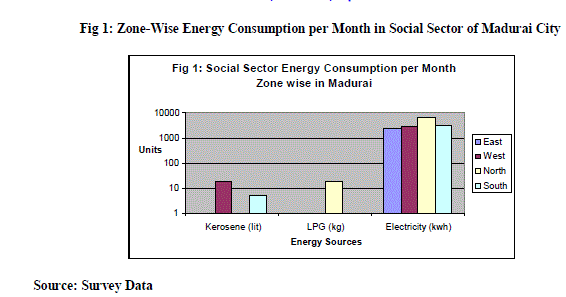 |
Source: Survey Data |
| From Figure 1, it has been inferred that in the case of social sector in east zone, total of 2426 kwh of electricity is consumed as a source of energy whereas, in the case of social sector in west zone, maximum of 2960 kwh of electricity and 18 liters of kerosene are consumed as source of energy. Further, it also shows that in the case of social sector in north zone, maximum of 6218 kwh of electricity and 19.1 kg of LPG are consumed. In case of social section in south zone, maximum of 3130 kwh of electricity and 5 liters of kerosene are consumed as source of energy. |
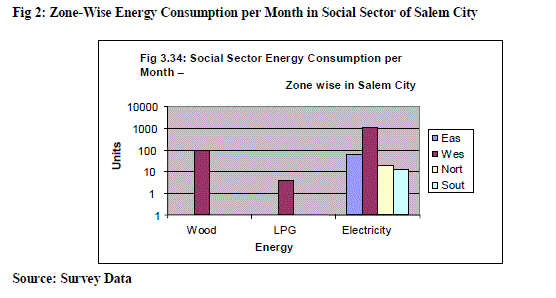 |
Source: Survey Data |
| It has been inferred from the Figure 2 that in the case of social sector in east zone in Salem city, total of 660 kwh of electricity is consumed as a source of energy whereas, in the case of social sector in west zone, 10897 kwh of electricity is consumed followed by 100 kg of wood and 38.2 kg of LPG. Further it also shown that in the case of social section in north zone; 20 kwh of electricity is consumed as source of energy while in the case of social section in south zone, 120 kwh of electricity is consumed as a source of energy. |
| Table 1 and 2 indicate the zone-wise energy use pattern (mega joules) in social sector of Madurai and Salem cities, respectively. |
 |
| It has been observed from the table 1 that in the case of social sector in east zone in Madurai city, total of 8733.6 Mega Joules of electricity is consumed as a source of energy whereas, in case of west zone 612 Mega Joules of kerosene is consumed. Further, it also shows that in the case of north zone, maximum of 22384.8 Mega Joules of electricity and 851.6 Mega Joules of LPG are consumed as source of energy whereas, in the case of south zone, maximum of 11268 Mega Joules of electricity and 170 Mega Joules of kerosene are consumed as source of energy. |
| From the table 2, it has been inferred that in the case of social sector in east zone, total of 2376 Mega Joules of electricity is consumed as a source of energy whereas, in the case of social sector in west zone, maximum of 39229.2 Mega Joules of wood and 1703.7 Mega Joules of LPG are consumed as source of energy. Further, it also reveals that in the case of north zone, 720 Mega Joules of electricity is consumed as a source of energy and in the case of south zone, 432 Mega Joules of electricity is consumed as a source of energy. |
 |
| It is found from table 3 that there exists a significant variation in kerosene consumption for cooking, hot water, etc. between Madurai and Salem cites. There is no evidence in significant variation in the zone-wise consumption of electricity in social sector between Madurai and Salem cities. |
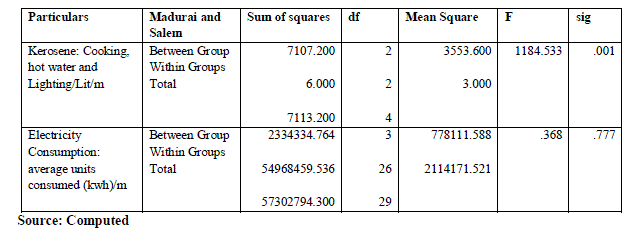 |
| Source: Survey Data |
| NU- Not in Use |
| From table 4, it has been observed that in the case of kerosene as source of energy in Madurai, a maximum of Rs. 540 is spent in west zone and Rs. 150 in spent in south zone whereas, in the case of LPG as a source of energy, total of Rs. 15300 is spent in north zone. Further, it also shows that in the case of electricity as a source of energy, maximum of Rs 37545 is spent in north zone followed by Rs.19755 is spent in south zone, Rs 15847 is spent in west zone and Rs 13818 is spent in east zone. |
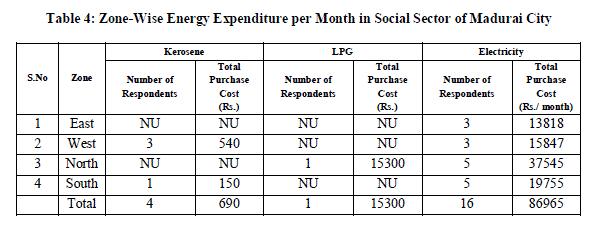 |
| It has been revealed from the table 5 that in the case of wood as a source of energy in Salem city, a total of Rs. 2500 is spent in west zone whereas, in the case of LPG as a source of energy, a total of Rs. 1650 is spent in north zone. Further, it also shows that in the case of electricity as a source of energy, maximum of Rs. 54052 is spent in west zone followed by Rs. 4000 is spent in east zone, Rs. 770 is spent in south zone and Rs. 117 is spent in north zone. |
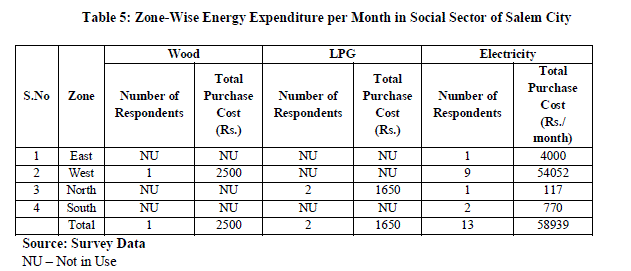 |
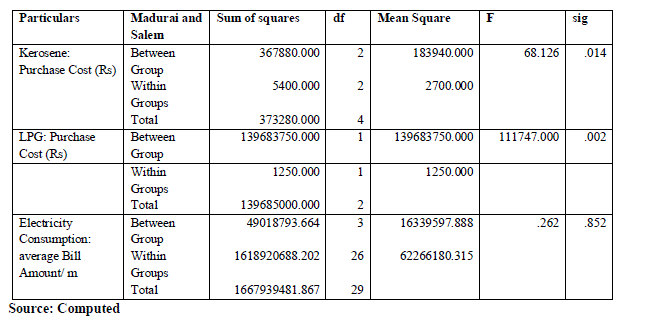 |
| It is inferred from table 6 that there was a significant variation in zone-wise energy consumption cost for kerosene and LPG in social sector between Madurai and Salem cities. However, there is no evidence in variation in energy consumption cost for electricity consumption between Madurai and Salem cities. |
VI.CONCLUSION |
| In Social Sector, zone-wise analysis indicated that all the four zones were consumed electricity as a source of energy followed by LPG in both Madurai and Salem cities. The significant variation was observed in the usage of kerosene between two cities according to ANOVA test. Regarding zone-wise energy expenditure in west zone, kerosene was found to be maximum whereas, in the case of south zone in Madurai city, a maximum amount was spent for electricity followed by kerosene. In Salem city, a maximum amount was spent for electricity in west zone followed by wood. The ANOVA test revealed that there existed a significant difference in zone-wise energy consumption expenditure for kerosene and LPG in social sector between Madurai and Salem cites. |